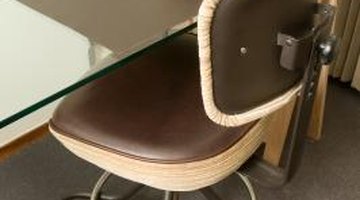Chair Mats & Moisture Problems
Chair mats are thin plastic mats that sit over your flooring material to prevent scratches and scuffs; they allow chairs with wheels to roll easily over carpeting. Using a chair mat in a high-moisture environment, or during the humid months, may create moisture issues between the mat and the carpeting or floor. Over time, this can lead to mold and mildew problems. There are several ways to prevent this problem with chair mats.
Cause: Slabs

If the room in which you are using your chair mat is built on a slab foundation, you may find significant amounts of water accumulating on the underside of your chair mat. As moisture is released from the concrete slab, it passes up through the carpeting and, usually, evaporates into the air. In areas where there is an impermeable barrier, such as a chair mat, the moisture will become trapped and condense. Concrete is continuously absorbing and releasing moisture, so the solution to your condensation issue lies with your chair mat.
Cause: High Humidity
Humidity is a measurement of the evaporated water in the air. Humidity can make otherwise comfortable temperatures feel muggy and close. Additionally, it can cause condensation and moisture issues in your carpeting, especially under a chair mat. Humid air becomes trapped between your chair mat and the carpeting and, as the chair mat is below the indoor dew point, the water condenses on the underside of the mat.
Solution: Ventilated Chair Mats
Many chair mat manufacturers have designed mats with the specific intention of encouraging air flow and reducing the likelihood of moisture problems. These chair mats are manufactured with small feet or teeth that keep the mat slightly up off the floor or carpet. Additionally, they have small ventilation holes that allow air to circulate under the mat, reducing the places where moisture can be trapped. These mats can go a long way toward eliminating moisture issues.
Solution: Reduce Indoor Humidity
Many modern air conditioners have a thermostat that allows homeowners to set the desired humidity level for their home. When the humidity percentage rises above the setting on the thermostat, the air conditioner cycles on and dehumidifies the air. Alternatively, simply turning on the air conditioner or running a dehumidifier will work to reduce the indoor humidity. Reducing the indoor humidity will not only improve the comfort level of your home, but will help reduce the amount of moisture in the air and the amount of moisture available to become trapped under your chair mat.
References
Writer Bio
Andrew Leahey has been a writer since 1999, covering topics as varied as technology how-to guides and the politics of genetically modified organisms to African food supplies. He is pursuing his J.D. while renovating an 1887 farmhouse located in the New Jersey Pine Barrens.
Photo Credits
- Jupiterimages/Photos.com/Getty Images
More Articles
- How to Get Rid of Fleas in Your Carpet with Borax and White Vinegar
- How to Dry out a Wood Chair That Was Left in the Rain
- What is the Difference in Height of Patio Chairs?
- How to Remove Children's Bubble Fluid From the Carpet
- How to Stop Sliding a Recliner Swivel Base on the Carpet
- How to Clean Rock Salt Out of Carpet



